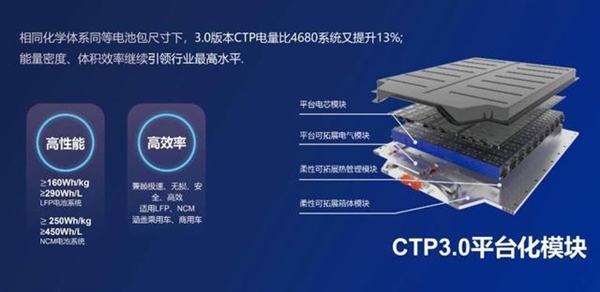
6-18 #ShenzhenWeather : TSMC has formally unveiled its N2 (2nm class) fabrication technology; GlobalFoundries and STMicroelectronics are reportedly in talks to build a semiconductor factory in France; Sony Group and Honda Motor have announced that they have signed a joint venture agreement; etc.

The European smartphone market declined by 12% YoY in 1Q22, according to Counterpoint Research. There are 49M smartphones shipped in Europe in 1Q22, the lowest first quarter total since 1Q13. Samsung remained as the region’s top vendor, despite a significant drop in shipments. realme was the only top-five vendor to register annual shipment growth in 1Q22. Deteriorating macro and geopolitical environment expected to drive further declines in 2022. (GSM Arena, Gizmo China, Counterpoint Research)
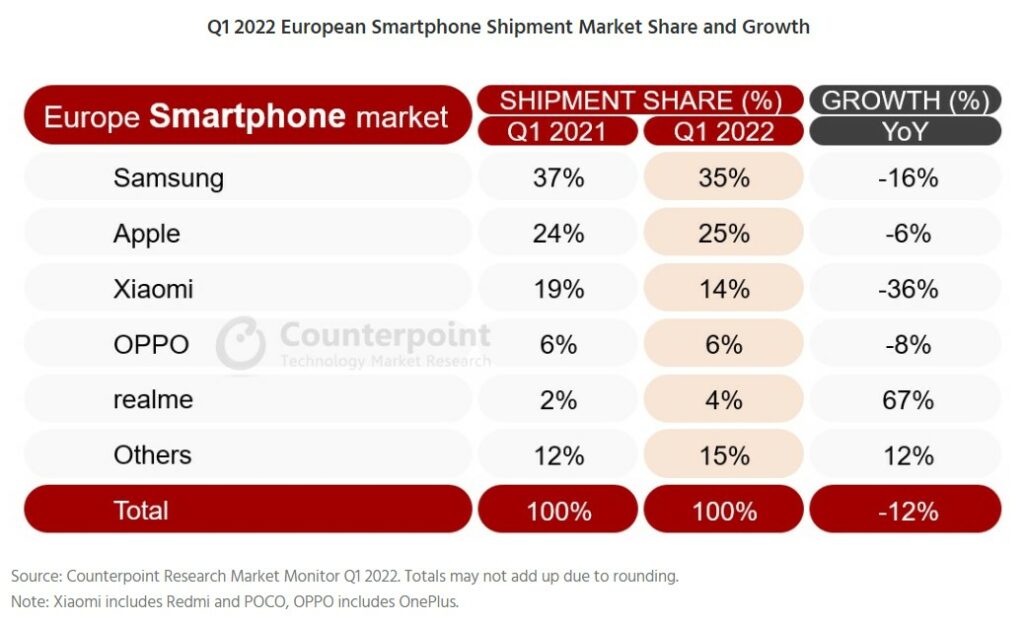
“Made in India” smartphone shipments grew 7% YoY in 1Q22 to reach over 48M units, according to Counterpoint Research. The local smartphone manufacturing ecosystem stayed resilient amid global component shortages. Smartphone manufacturing is increasing in India. In 2021, the shipments of “Made in India” smartphones crossed 190M units. The increasing smartphone demand in India as well as increasing exports are the major reasons for the continued growth. Support has also come from the Indian government’s various initiatives to increase local manufacturing. However, the manufacturing of feature phones declined 41% YoY in 1Q22 due to falling demand for the past few quarters. In the smartphone segment, the third-party EMS (electronic manufacturing services) providers captured 42% share in local manufacturing, registering 4% YoY growth in terms of shipments. OPPO led the “Made in India” smartphone shipments with a 22% share, followed closely by Samsung at 21%. (Counterpoint Research)
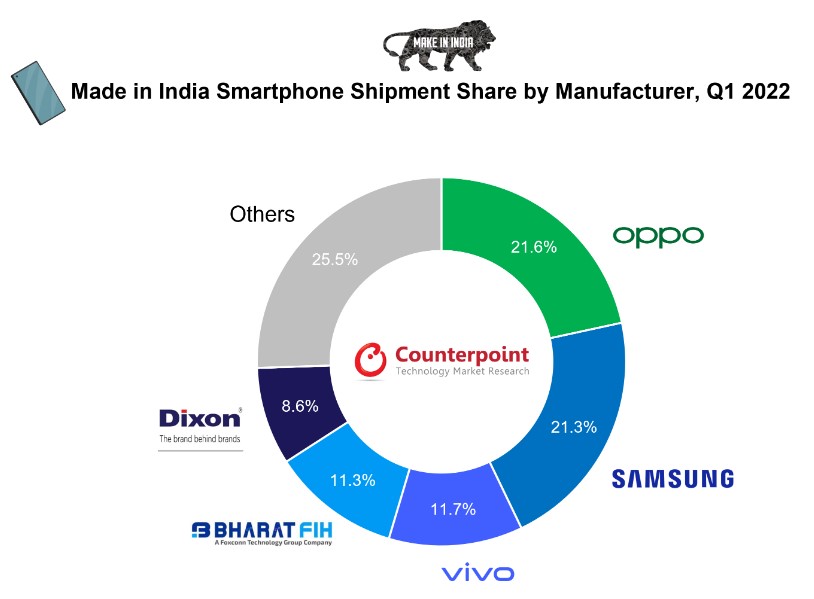
In 2022, the Kantar BrandZ Global Top 100 Most Valuable Brands grew by 23% YoY to a total value of nearly USD8.7T. With a 55% increase in brand value, Apple rose one spot to secure the number one spot on Kantar BrandZ global rankings for the first time since 2015. With a total brand value of USD947,062M, Apple is now the clear global leader in brand value, thanks to its strength across its hardware, software, and services offerings. (CN Beta, Kantar, report, WCCFtech, CN Beta)
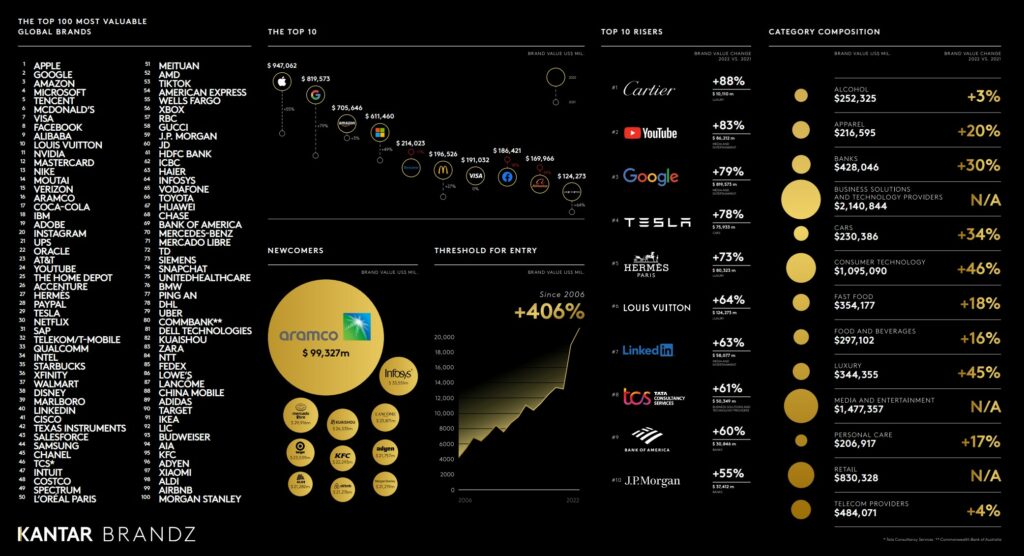
Samsung is reportedly to cancel Samsung Galaxy S22 FE (“Fan Edition”). It was a big deal when Samsung launched the Galaxy S20 FE back in Sept 2020. It had been a few years since it launched an FE-branded phone. Samsung has said that the Galaxy S20 FE was a “flagship” device. The company has also said that it would release a new FE variant for Galaxy S flagships every year. (Digital Trends, SamMobile)
Apple will begin shipping repaired iPhone 12 models in a new brown box that is 100% plastic free and created with bleach-free paper certified by the Forest Stewardship Council. The Forest Stewardship Council (FSC), an international non-profit NGO established in 1993, promotes responsible management of the world’s forests with standards on forest products, along with certifying and labeling them as eco-friendly. Until now, all repaired iPhones shipped by Apple were packaged in a white box. Apple is trialing the new packaging for repaired iPhones as part of the company’s commitment to eliminate plastics in all packaging by 2025.(MacRumors, MobileSyrup, Apple World)

realme has extended its partnership with KHY Electronics to locally manufacture audio products in Noida. It is also in talks with a few other Indian contract manufacturers to bring a host of hearable and wearable ecosystems to the country, according to realme’s CEO Madhav Sheth. realme is also looking to begin local manufacturing of laptops and tablets by early 2023 and has also started discussions with three potential partners. realme India CEO Madhav Sheth has indicated that the company has invested INR26.7 crore just to make one product with KHY and will continue to invest further as they bring more products to India. They will be bringing 6-8 products in the category before the 2022 end. Currently, OPPO, Wingtech Mobiles, and DBG Technology manufacture smartphones for realme, while Bhagwati and Videotex handle smart TVs for the brand. realme’s target is to locally produce 300,000 units of audio products by the end of 2022. Their partner has a 3.5M total capacity across product categories.(GizChina, 91Mobiles, Economic Times)
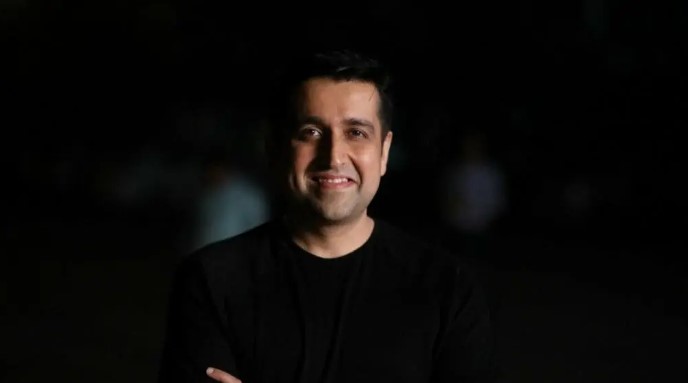

Meta CEO Mark Zuckerberg has announced today that the company is launching a digital designer clothing store called the “Meta Avatars Store”. The new virtual store is launching on Facebook, Instagram and Messenger and will allow users to buy digital clothes for their avatars. The store will begin rolling out in end Jun 2022 and will initially offer digital outfits from Balenciaga, Prada and Thom Browne. Meta plans to make the store an open marketplace where developers can create and sell clothing.(CN Beta, TechCrunch, Facebook)


Display Supply Chain Consultant (DSCC) has reported that Samsung has seen a substantial drop over 2 years. Samsung’s late-20% share in 2019 dropped to late-10% in 2021. It dipped below 20% for the first time during 4Q20 and dropped to 13% during 4Q21. What DSCC calls premium TVs include liquid crystal display (LCD) with quantum dot films, what Samsung brands QLED, as well as LCD TVs with LED backlights, 8K LCD TVs and OLED TVs. From the share drop, Samsung lost its place as the top TV vendor in China to Huawei. Huawei increased its premium TV share from 10% in 2019 to late-20% in 2021, DSCC said. (The Elec, Gizmo China, Laoyaoba)

Key affiliates of Samsung Group, including Samsung Electronics, Samsung SDI, Samsung SDS and Samsung Electro-Mechanics, have launched a task force focused on electric vehicles (EVs). The task force is reportedly studying EVs from various angles at Samsung Seocho Building in southern Seoul. Samsung SDI, Samsung Electro-Mechanics, Samsung Display and other Samsung Group units produce various core components of EVs, such as batteries, autonomous driving chips, vehicle semiconductors, camera modules, and organic light emitting diode (OLED) displays. They are rolling out core products except for power drive systems.(Business Korea, CN Beta)
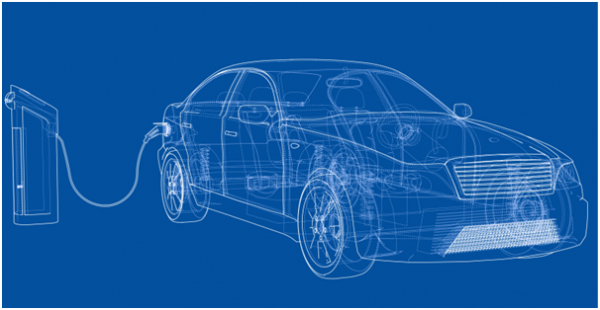
Sony Group and Honda Motor have announced that they have signed a joint venture agreement to establish a new company to engage in the sale of high-value-added electric vehicles (EVs) and provide services for mobility. The new company will aim to bring together Honda’s cutting-edge environmental and safety technologies, mobility development capabilities, vehicle body manufacturing technology and after-sales service management experience, with Sony’s expertise in the development and application of imaging, sensing, telecommunication, network and entertainment technologies, to realize a new generation of mobility and services for mobility that are closely aligned with users and the environment, and continue to evolve going forward. Sony and Honda plan to establish the new company within 2022 and to begin the sale of EVs and provision of services for mobility in 2025. The establishment of the new company and the start of business are subject to relevant regulatory approvals.(Engadget, Sony, CN Beta)
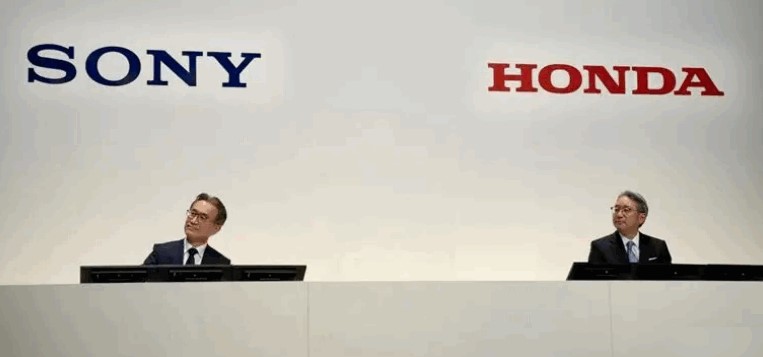
Swedish digital audio pioneer Dirac and Dolby have announced a collaboration to provide the ultimate in immersive automotive audio experience. The partnership melds Dirac’s optimization algorithms with Dolby Atmos support to deliver 3D sound as well as improve audio quality across the board. The first car to take advantage of Dolby and Dirac tech is the Nio ET7, which will be launched in Europe later 2022. (Engadget, Audio Express, TechRadar)


Boston-based Corvus is launching Corvus Robotics to track warehouse inventory. Corvus is positioning its product as the “first unmanned warehouse inventory drones to enable fully automated inventory management,” though the company is far from alone in its solution. Corvus’s drones are custom built for the job, featuring indoor obstacle avoidance and the ability to read barcodes, even in low-light warehouse conditions. The systems also feature an on-board autonomy stack, so they can keep operating even in poor Wi-Fi conditions — which are a bit of a constant in these sorts of settings. (CN Beta, IEEE, TechCrunch, Yahoo)
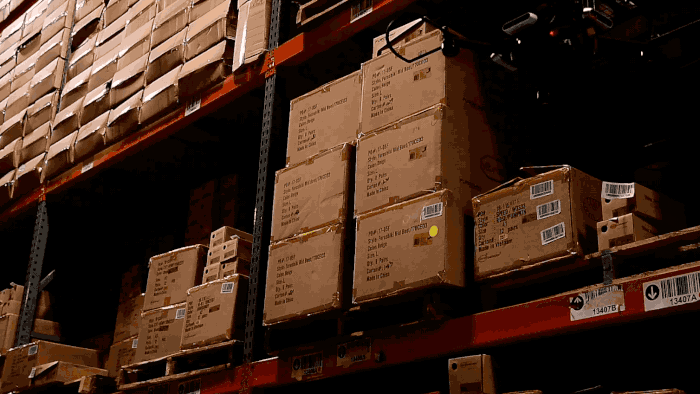

Samsung has launched Samsung Wallet, a platform to help users manage their digital keys, payment methods, identification, boarding passes, and more. Samsung says its new platform uses defense-grade security and encryption — in the form of Samsung Knox — to help protect users’ most sensitive information. A combination of fingerprint recognition and encryption helps protect the data and ensures that only the user has access to it. Samsung Knox also sequesters the most sensitive data stored in Samsung Wallet into an isolated environment, providing an additional layer of protection against both physical and digital hacking.(Android Headlines, Android Authority, CN Beta, Samsung)
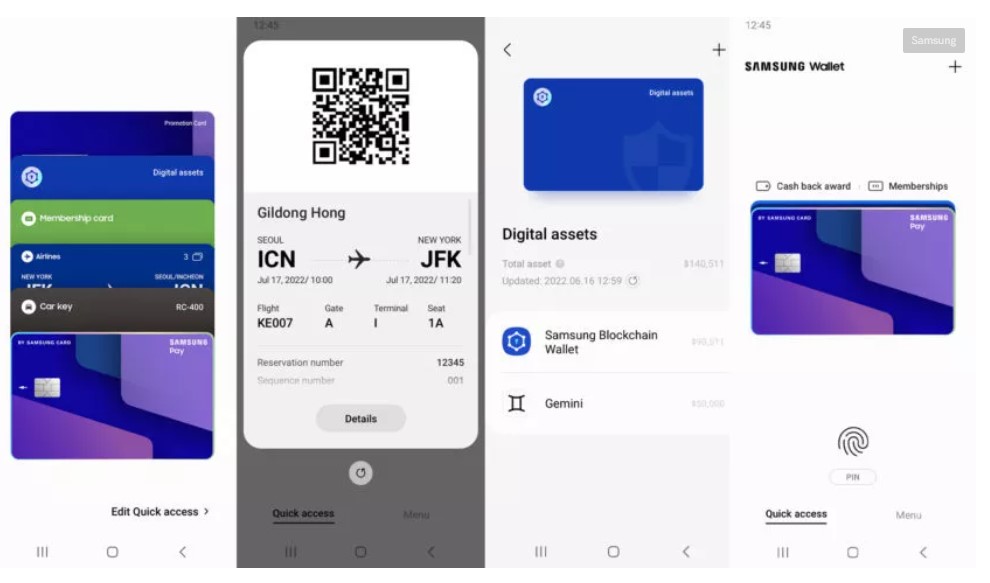

TSMC has formally unveiled its N2 (2 nm class) fabrication technology, which is slated to go into production some time in 2025 and will be TSMC’s first node to use their nanosheet-based gate-all-around field-effect transistors (GAAFETs). TSMC’s N2 is a brand-new platform that extensively uses EUV lithography and introduces GAAFETs (which TSMC calls nanosheet transistors) as well as backside power delivery. TSMC promises that N2 will allow chip designers to increase performance by 10% to 15% at the same power and transistor count, or reduce power consumption at the same frequency and complexity by 25% ~ 30%, all the while increasing chip density by over 1.1-fold when compared to N3E node. TSMC expects to start risk production of chips using its N2 fabrication process sometimes in 2H24, which means that the technology should be available for high volume manufacturing (HVM) of commercial products in 2H25.(CN Beta, My Drivers, AnandTech, AnandTech, Tom’s Hardware)
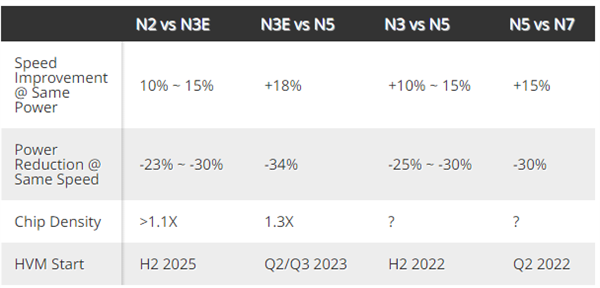
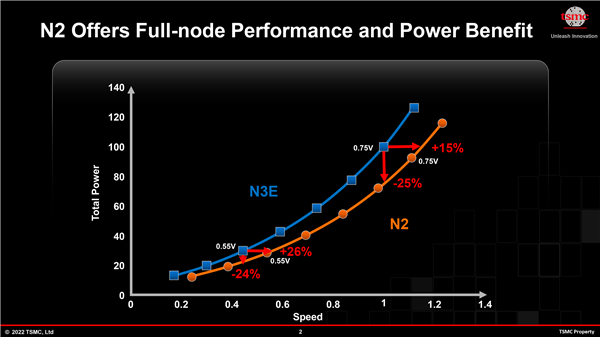
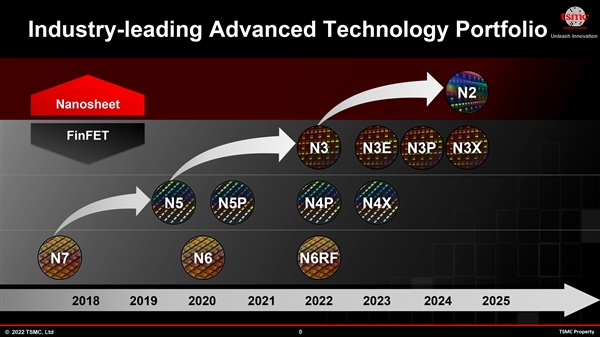
GlobalFoundries and STMicroelectronics are reportedly in talks to build a semiconductor factory in France with the help of government funds. New York-based GlobalFoundries and Geneva-based STMicroelectronics are hoping to get government subsidies for the French fab as part of the EU’s proposed European Chips Act. If the France fab is expected to produce “energy efficient chips with advanced technologies”, there is a chance it could be related to a collaboration GlobalFoundries and STMicroelectronics announced earlier 2022 around FD-SOI technology that can be used to make low-power chips for automotive, IoT and mobile applications. (CN Beta, The Register, Evertiq, Bloomberg)
Taiwan’s chipmakers have launched an unprecedented investment spree worth around USD120B that will strengthen their grip on the global market, even as the U.S. warns against overreliance on an island at risk of a Chinese invasion. The industrial park in the city of Tainan began as a production hub for Taiwan Semiconductor Manufacturing Co (TSMC), the world’s leading contract chipmaker. It is home to some of the most advanced chip fabs in the world, producing processors for Apple iPhones. TSMC has just completed 4 new facilities in the area. Still hungry for capacity, the company is now building four more fabs there for production at the cutting-edge 3nm level. Each of these locations will cost around USD10B. (Laoyaoba, Asia Nikkei)
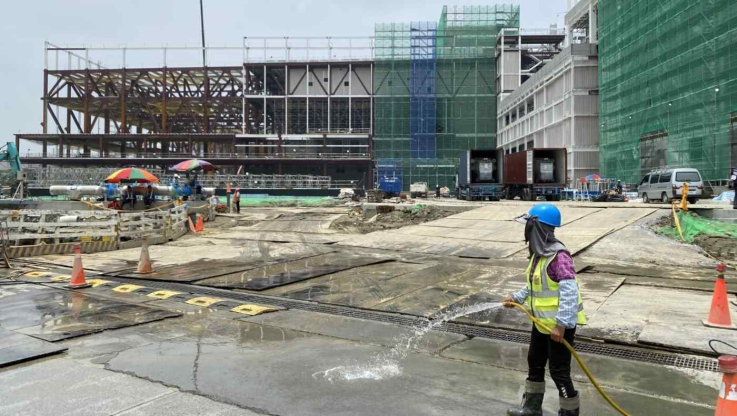
TSMC has disclosed that it will expand its production capacity for mature and specialized nodes by about 50% by 2025. The plan includes building numerous new fabs in Taiwan, Japan, and China. The company is investing in four new facilities for mature and specialty nodes: Fab 23 Phase 1 in Kumamoto, Japan. This semiconductor fabrication facility will make chips using TSMC’s N12, N16, N22, and N28 nodes and will have a production capacity of up to 45,000 300-mm wafer starts per month. Fab 14 Phase 8 in Tainan, Taiwan. Fab 22 Phase 2 in Kaohsiung, Taiwan. Fab 16 Phase 1B in Nanjing, China. TSMC currently makes chips on its N28 in China, though the new phase was once rumored to be capable of making chips using more advanced nodes. Increasing mature/specialized capacity by 50% over the next three years is a big shift for the company, and one that will improve TSMC’s competitive positions on the market.(CN Beta, Tom’s Hardware, AnandTech)
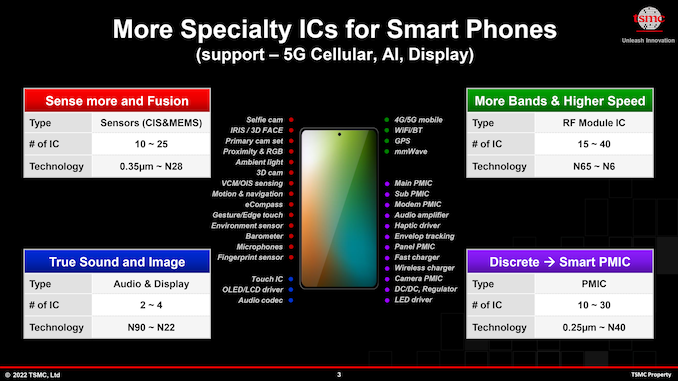
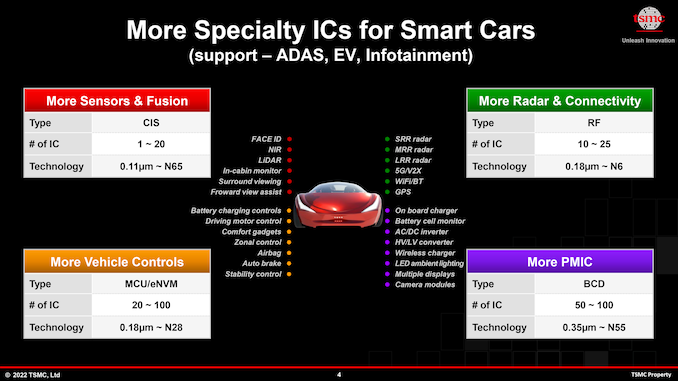
YJ Mii, TSMC’s senior vice-president of research & development, has revealed that TSMC will have the next version of ASML’s most advanced lithography tool in 2024. Kevin Zhang, TSMC senior vice-president of business development, later clarified that TSMC wouldn’t be ready for production with the new high-NA EUV tool in 2024 but that it would be mostly used for research purposes with partners.(CN Beta, Reuters, Business Times)
Malaysian companies from palm oil plantations to semiconductor makers are refusing orders and forgoing billions in sales, hampered by a shortage of more than a million workers that threatens the country’s economic recovery. Malaysia lacks at least 1.2 million workers across manufacturing, plantation and construction, a shortage worsening daily as demand grows with an easing of the pandemic, industry and government data show. Manufacturers say they are short 600,000 workers, construction needs 550,000, the palm oil industry reports a shortage of 120,000 workers, chipmakers lack 15,000 and cannot meet demand despite a global chip shortage, and medical glovemakers say they require 12,000 workers. (Laoyaoba, Reuters)
Samsung Electronics Vice Chairman Jay Y. Lee has met with ASML CEO Peter Wennink to discuss cooperating over the adoption of high-end chip equipment. ASML’s EUV machines are key to advanced chipmaking and cost up to USD160M each, and the limited number produced has created a bottleneck for chipmakers like Samsung, TSMC and Intel which have plans to spend more than USD100B in coming years to build semiconductor plants. In 2021, ASML’s EUV equipment annual shipment will be 48 units, of which 15 units will be won by Samsung and 20 units will be arranged by TSMC. In 2022, ASML’s EUV lithography machine shipments are estimated to be 51 units, of which Samsung has reserved 18 units and TSMC has secured at least 22 units. If Samsung can win more EUV machines this time, it will get at least 18 in 2022, but Samsung has not detailed the content of the “extra” EUV equipment obtained this time. (CN Beta, Techzine, US News)
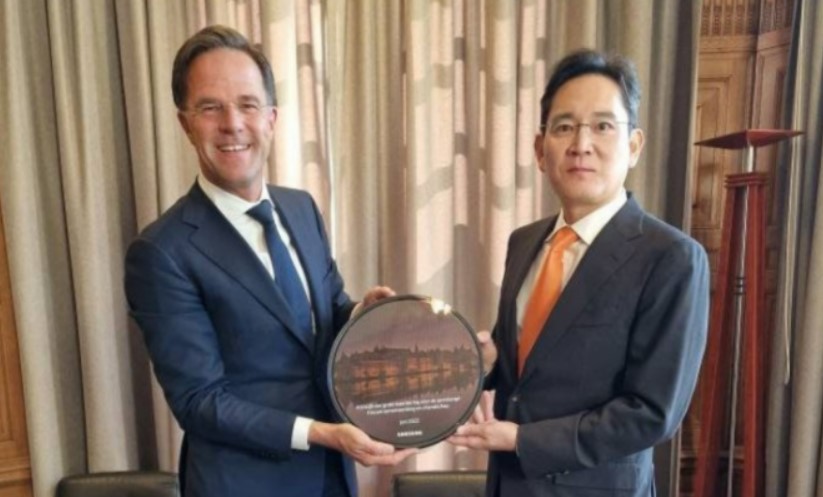
According to Korean International Trade Association (Kita), a week-long strike by truck drivers in South Korea has disrupted shipments to China of a key material used in the production of semiconductors. It is the first concrete sign that the strike is impacting chip production, having already cost South Korean industrial sectors more than USD1.2B in lost production and unfilled deliveries. Kita has said a Korean company that produces isopropyl alcohol, a raw material for cleaning chip wafers, is facing complications in shipping to a Chinese company that in turn supplies wafers to a Samsung Electronics factory in China. Samsung Electronics did not immediately comment. It produces NAND flash memory chips. (Laoyaoba, The Guardian, Reuters, RTHK, OLT News)
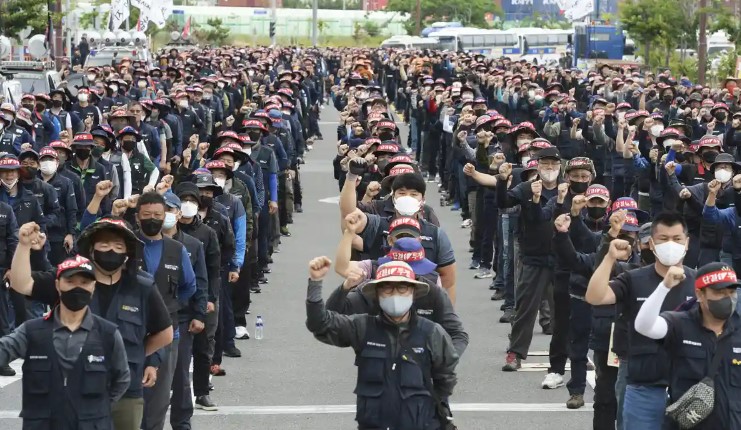
The Arm-based mobile computing chip market (smartphones, tablets and notebook PCs) grew 27% to USD35.1B in 2021, according to Strategy Analytics. Qualcomm led the Arm-based mobile computing chip market with a 34% revenue share, followed by Apple with 31% and MediaTek with 24%. Smartphone, tablet, and notebook PC processors accounted for 88%, 9% and 3% of total Arm-based mobile computing chip revenue in 2021. (Strategy Analytics)
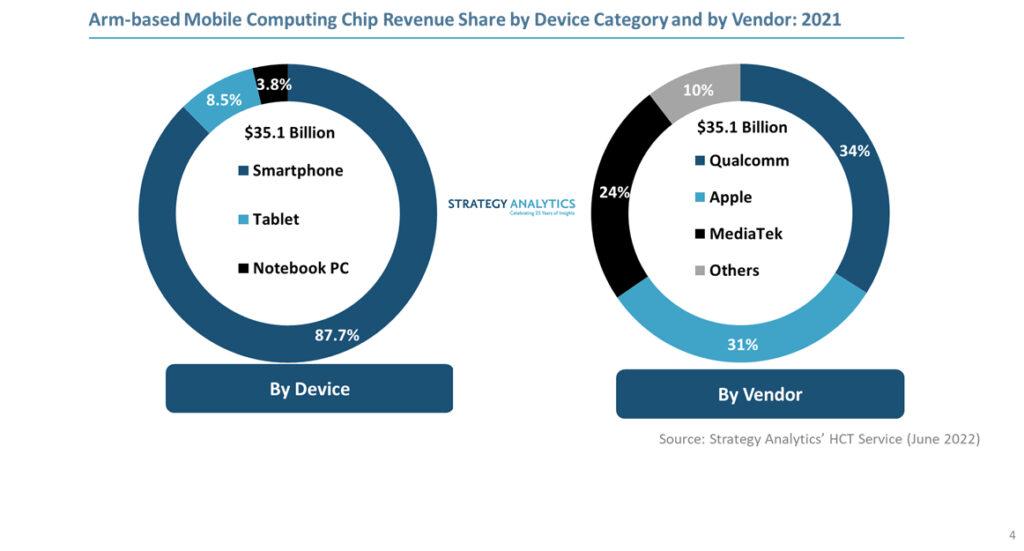
Marvell Technology is looking to expand its Canadian presence in Ottawa, Toronto and Vancouver with plans for ongoing growth. Canada is, according to the company, a market of growing strategic importance as the company continues to “advance its leadership in cloud-optimized silicon”. Additionally, Marvell has plans to engage with eight additional universities for the 2023 calendar year.(Laoyaoba, Marvell, Evertiq)
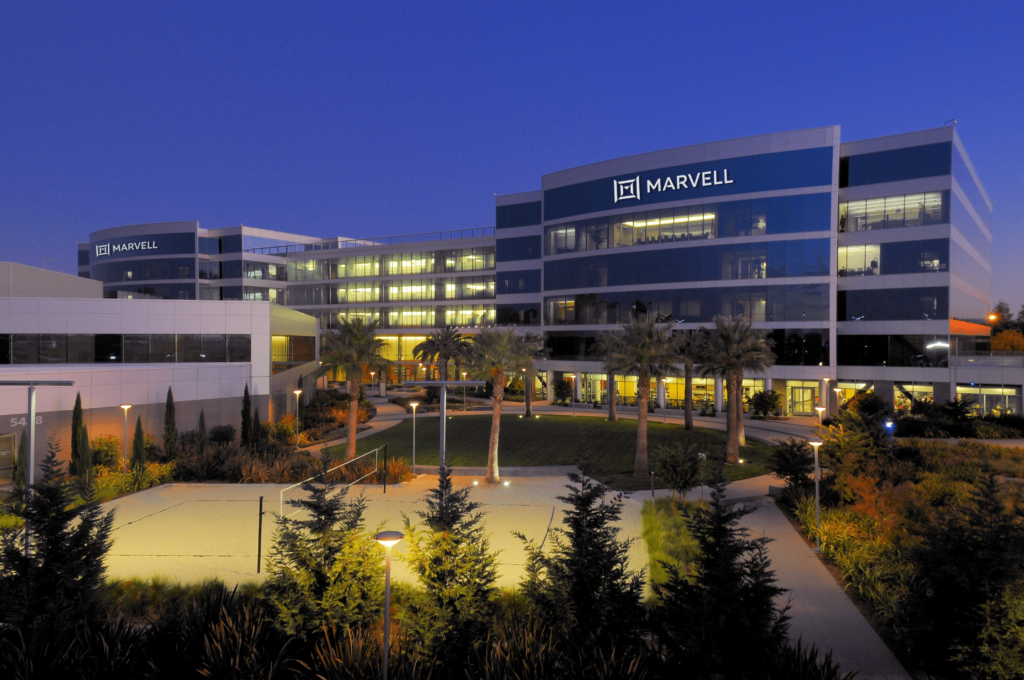
According to Market Intelligence & Consulting Institute (MIC), the global semiconductor market is expected to reach USD613.5B in 2022, a YoY increase of 10.4%. Among them, the output value of IC design this year will exceed NTD1T for 2 consecutive years, establishing its status as a “trillion-yuan industry”” Among them, the annual revenue growth rate of IC manufacturing is the highest, reaching 25%, mainly from the price increase in 1H22 and the introduction of newly built capacity, and the estimated annual output value is nearly NTD2.2T. In addition, according to the MIC analysis of the Information Policy Council, the output value of Taiwan’s IC design industry in 2021 has exceeded NTD1T. It is estimated that the annual revenue will continue to increase by 10% to 15% in 2022, and the output value will reach NTD1.27T. (China Times, CNYES, UDN, MIC)

LG Display (LGD) has announced that it will borrow USD1B from major global financial companies to expand OLED module lines at its Vietnamese plant. LGD will use the funds to expand OLED module lines at its Vietnamese plant. The ultimate goal is to expand its presence in the global small and medium-sized OLED panel market. Although LGD is an undisputed No. 1 player in the large OLED panel market, it has a share of about 12% in the market of small and medium-sized OLED panels, much smaller than Samsung Display’s 73%. In 2021, LGD decided to make a massive investment in its Paju plant in Gyeonggi Province, Korea and in its Vietnamese plant to increase its competitiveness in the small and medium-sized OLED panel market.(Laoyaoba, Business Korea)
TCL Technology has said that the display industry is facing demand fluctuations in the short term, and the price changes of TV, monitors and notebook products are different. TCL Huaxing Optoelectronics has strengthened its LCD medium-sized business through t9 investment, and the competitiveness of its business portfolio has been effectively enhanced; t3 production expansion has been promoted in an orderly manner. After the expansion is completed, it will become the world’s largest and most competitive LTPS production line.(Laoyaoba, 163)
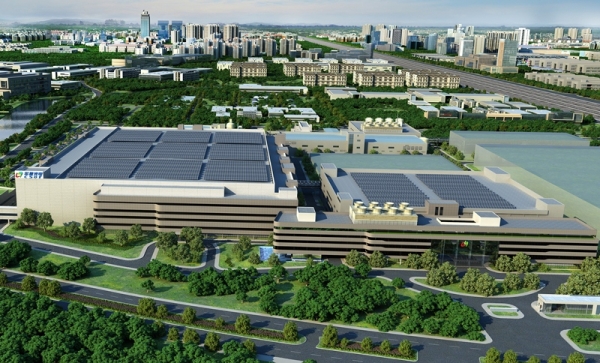
Samsung Electronics has set a shipment target of 15M units for its fourth foldable smartphone to be released in Aug 2022. It is understood that Samsung Electronics has ordered parts that can produce about 18M foldable smartphones in consideration of production yield and inventory. The shipment ratio of Galaxy Fold 4 and Flip 4 is about 2 to 1. Samsung Electronics originally sold more Galaxy Flip-type foldable smartphones. In 2022, the proportion of Galaxy Fold 4 shipments was slightly higher compared to 2021. (CN Beta, SamMobile, ET News)

Tianma has announced that it has successfully commercialized in-cell touch AMOLED displays, and it is now starting to mass produce the first such display to a customer, a well-known smartwatch maker that will ship the product in 3Q22, globally. Tianma explains that by adopting the in-cell structure, it has managed to reduce the total screen thickness by 20%, compared to its current on-cell technology. The new AMOLED display is also lighter. Tianma also says that this display uses its latest Dynamic PVEE (pixelvee) technology which uses negative voltage to adapts to ambient light and conserve power under dark light conditions.(Laoyaoba, IT Home, LED Inside, OLED-Info)
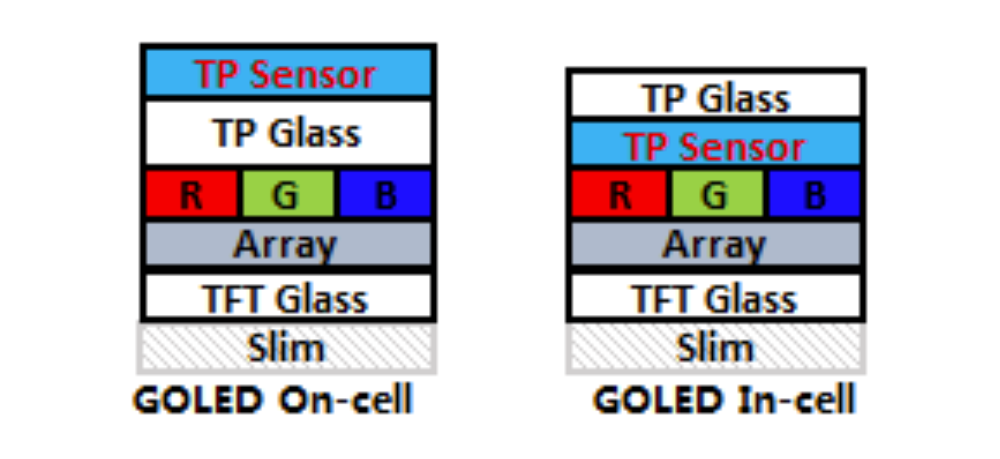

Toshiba, Sony and Samsung Electronics have lost their court fight against an EU cartel fine levied seven years ago for colluding in procurement tenders for optical disc drives. The European Commission in 2015 fined five companies EUR116M (USD120.5M), with the biggest fine of EUR41.3M going to Toshiba Samsung Storage Technology, a joint venture of Toshiba and Samsung Electronics. Hitachi-LG Data Storage was fined 37 million euros. Other sanctioned companies were Sony, Sony Optiarc which is a joint venture between Sony and NEC, and Quanta Storage. Philips avoided a fine as it alerted the cartel to the EU competition enforcer. The Commission has said the collusion concerned optical disk drives for laptops and desktops produced by Dell and Hewlett Packard. The General Court in 2019 agreed with the Commission’s finding of a cartel and threw out the companies’ challenge.(CN Beta, Reuters, NASDAQ)
Samsung Electronics is reportedly reevaluating supply and demand amid concerns over global inflation levels. The company has temporarily suspended orders for several components that are required to manufacture various consumer electronics. Samsung appears to have sent a notice to multiple suppliers asking them to delay shipments or reduce part orders due to bloated inventories. Samsung is allegedly asking for fewer chips and other components needed for manufacturing products in several device categories, including smartphones, TVs, and home appliances. In Apr 2022, the delivery cycle of Samsung’s PC storage and solid-state drives is still as high as 52 weeks, but the price and delivery period have stabilized, and the delivery period and price of memory modules and eMMC are still on the rise. In the field of memory, dynamic random access memory (DRAM) is the most widely used category, with a product market share of about 60%; followed by NAND with about 36%, and NOR Flash with a very small share of about 3%. (Android Headlines, CN Beta, SamMobile, IT Home)
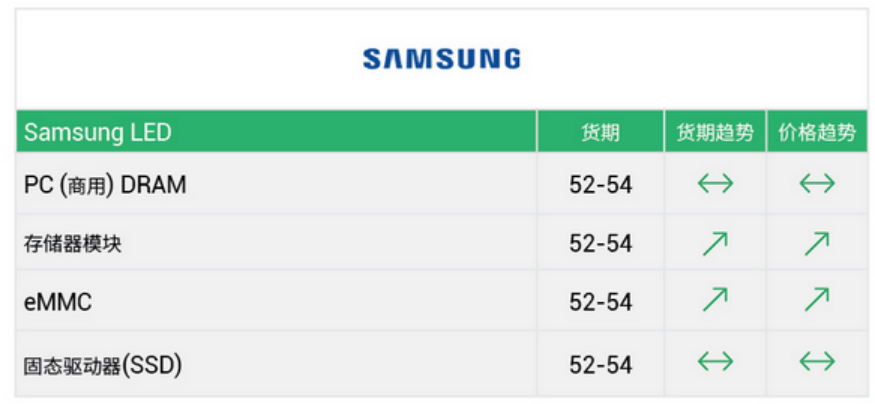
As for NAND flash memory, we all know that SLC, MLC and later TLC and QLC flash memory have the problems of lower and lower performance and higher error rate, but the capacity is larger, so flash memory manufacturers have been developing more flash memory. Kioxia’s research has reached the 7bit/cell level, and it needs to be tested in a low temperature environment of minus 200 degrees. MLC is actually 2bit/cell flash memory, TLC is 3bit/cell, QLC is 4bit/cell, and below is PLC flash memory, 5bit/cell. The research of flash memory giants such as Kioxia is more in-depth. In 2021, Kioxia announced research on 6bit/cell flash memory, which is HLC flash memory. However, the 7bit/cell flash memory has not been officially named yet, but the next generation of 8bit/cell has the name, called OLC flash memory. According to Kioxia’s research, in 7bit/cell flash memory, the channel material is changed from the previous polysilicon to monocrystalline silicon, which has lower resistance, reduced leakage current, and minimized threshold voltage fluctuations during write and read operations. (CN Beta, Tom’s Hardware, Guru3D, Fudzilla, PC.Watch)
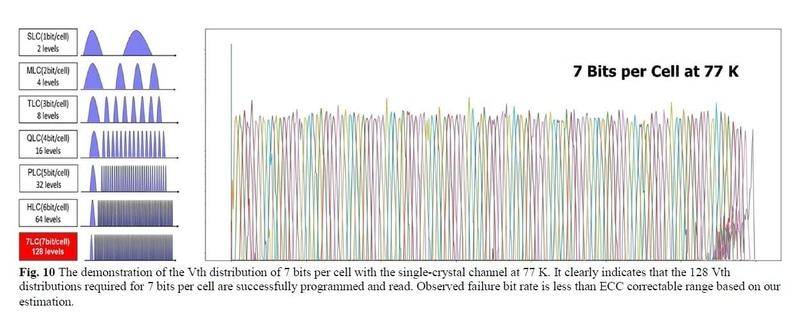
Corporate vice president and head of the Micron Taiwan, Lu Donghui has revealed that the company will add 2,000 employees and set up a research and development (R&D) corridor in Taiwan. Micron Technology is set to move its 1-gamma EUV process technology to volume production at its new fab, A3, in central Taiwan in 2024, and will install the first EUV equipment at the fab in 2H22. And as for 1-Beta DRAM Mass Production, it is reported that 1-Beta DRAM will be initially manufactured in Japan, and then the production will switch over to the Taiwanese plant later. For context, the current 1-Alpha DRAM is manufactured in the Taiwanese plant.(Laoyaoba, Forbes, Evertiq, Gizmo China)
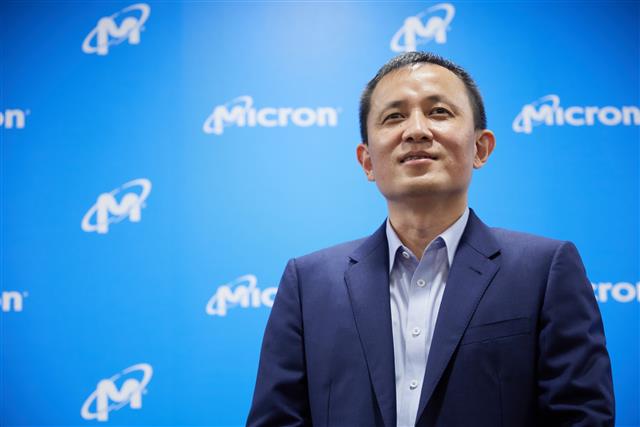

Samsung SDI is reportedly ramping up facilities for cylindrical batteries to supply its products to Tesla and other electric vehicle makers. The company is currently expanding production lines for smaller batteries at its Cheonan plant, and some of which will be converted to pilot facilities to make bigger ones for electric cars. Samsung SDI is testing two types of large-size cylindrical batteries. One is the so-called 4680 battery, which is 46mm in diameter and 80mm in length, while the other one has the same diameter but is longer. If all goes to plan, Samsung will produce battery samples in 1H23 and start mass production in 2025.(CN Beta, Korea Economy Daily)
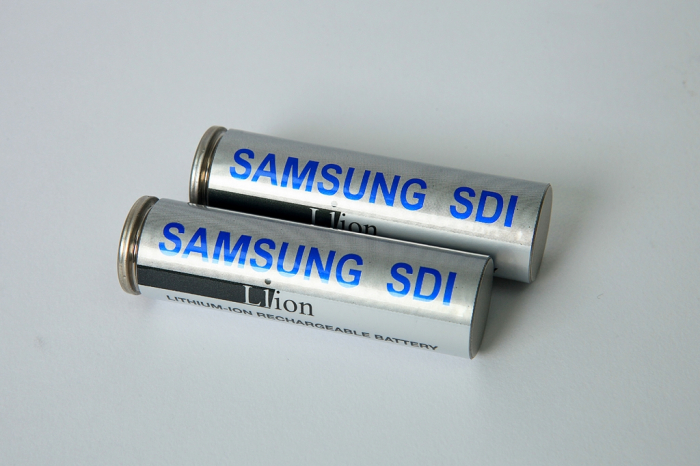
Wu Kai, the chief scientist of CATL, has said that the CTP (cell-to-pack) 3.0 battery, namely the Kirin battery, will be released soon. He has introduced that the Kirin battery adds a water-cooled sheet between the two cells to reduce the heat conduction of the two adjacent cells and prevent thermal runaway; secondly, it can meet high-voltage fast charging, and 4C charging is not difficult, and it can be done in 2023 and released in the market; third, it can greatly improve the battery life, because the water-cooled sheet has a buffering effect; fourth, the specific energy is improved, the Kirin battery can improve the utilization space, the energy density of the lithium iron phosphate system is 160wh/kg, and the ternary is high. Nickel can reach 250wh/kg, which is 13% more power than 4680 battery.(CN Beta, My Drivers, 163)
